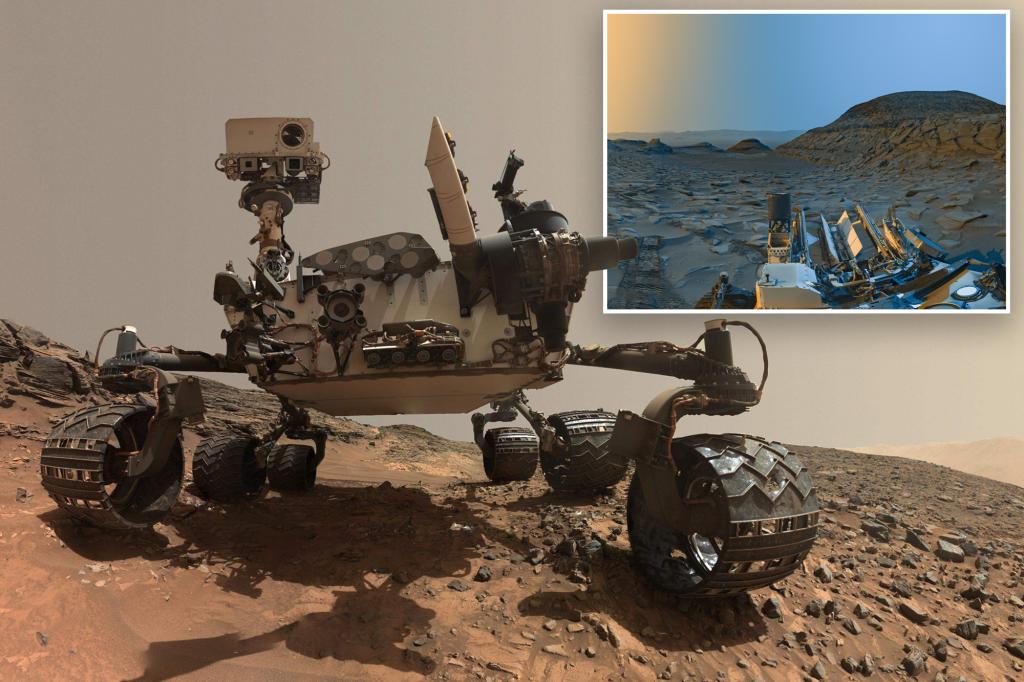A breakthrough instrument on NASA’s Mars Perseverance rover was deemed a mission success after producing enough oxygen for a small dog to breathe for about 10 hours.
The Mars In-Situ Oxygen Resource Utilization Experiment, or MOXIE, is a microwave-sized device that takes the unbreathable Martian air and turns it into the oxygen humans – and dogs – depend on.
The team behind the experimental instrument recently revealed that since Percy landed on Mars, MOXIE has been working like a dream.
MOXIE has generated 122 grams of oxygen since 2021, producing about 12 grams of oxygen per hour.
Because NASA knows we love a good animal analogy, the space agency says this is enough for a small dog to breathe for about 10 hours.
That may not sound like much, but it’s more than double NASA’s initial goal amount for MOXIE.
Oxygen is also at 98% purity or better.
 NASA’s Curiosity Mars rover uses its black-and-white navigation camera to capture the panorama twice a day on April 8, 2023.NASA/JPL-Caltech
NASA’s Curiosity Mars rover uses its black-and-white navigation camera to capture the panorama twice a day on April 8, 2023.NASA/JPL-Caltech
 This NASA file photo released on June 7, 2018 shows a low-angle self-portrait of NASA’s Curiosity Mars rover at the site where it reached down to drill a rock target called “Buckskin” at the base of Mount Sharp. AFP/Getty Images
This NASA file photo released on June 7, 2018 shows a low-angle self-portrait of NASA’s Curiosity Mars rover at the site where it reached down to drill a rock target called “Buckskin” at the base of Mount Sharp. AFP/Getty Images
“MOXIE’s impressive performance shows that it is possible to extract oxygen from the Martian atmosphere – oxygen that could help provide breathable air or rocket propellant to future astronauts,” said NASA Deputy Administrator Pam Melroy. “Developing technologies that allow us to use resources on the Moon and Mars is critical to building a long-term lunar presence, creating a robust lunar economy and enabling us to support early human exploration campaigns to Mars.”
MOXIE works through an electrochemical process, separating carbon dioxide molecules into oxygen and carbon monoxide molecules.
As this gas flows through the system, it is analyzed to check the purity and quantity of oxygen produced, according to NASA.
 Wheel footprints were left in the soil of Jezero Crater on Mars, as NASA’s Perseverance Mars rover drove over the Martian surface for the first time, in this March 4, 2021, image. Via REUTERS
Wheel footprints were left in the soil of Jezero Crater on Mars, as NASA’s Perseverance Mars rover drove over the Martian surface for the first time, in this March 4, 2021, image. Via REUTERS
 The Perseverance rover was seen in a “selfie” taking over the rock named “Rochette” on Sept. 10. 2021. via REUTERS
The Perseverance rover was seen in a “selfie” taking over the rock named “Rochette” on Sept. 10. 2021. via REUTERS
The achievement is interesting because when humans travel to Mars, they will be able to make oxygen and fuel on the Red Planet instead of transporting all their resources with them.
Using materials from the ground to survive is a technique called in-situ resource utilization, or ISRU.
MOXIE Principal Investigator Michael Hecht, with MIT, said the instrument has inspired the ISRU community.
 This NASA illustration shows a simulated depiction of NASA’s Interior Exploration using the Seismic Survey, Geodesy and Heat Transport Landers firing a retrorocket to slow down as it descends to the surface of Mars.AFP/Getty Images
This NASA illustration shows a simulated depiction of NASA’s Interior Exploration using the Seismic Survey, Geodesy and Heat Transport Landers firing a retrorocket to slow down as it descends to the surface of Mars.AFP/Getty Images
 NASA’s Perseverance rover is seen on Mars in this undated illustration provided by the Jet Propulsion Laboratory in Pasadena, Calif. via REUTERS
NASA’s Perseverance rover is seen on Mars in this undated illustration provided by the Jet Propulsion Laboratory in Pasadena, Calif. via REUTERS
“It shows NASA is willing to invest in this type of future technology. And it has been a flagship that has influenced the space resources industry very interestingly,” said Hecht.
This concept can be used to create a full-scale system with an oxygen generator like MOXIE and a way to store the oxygen produced.
NASA shares audio of the MOXIE air compressor at work on the Red Planet.
 NASA’s Curiosity Mars rover uses its black-and-white navigation camera to capture the panorama twice a day on April 8, 2023.Reuters
NASA’s Curiosity Mars rover uses its black-and-white navigation camera to capture the panorama twice a day on April 8, 2023.Reuters
Listen to the pumping device on Mars below.
On August 7, MOXIE generated oxygen for the 16th and final time on the rover before ending operations.
Categories: Trending
Source: thtrangdai.edu.vn/en/




